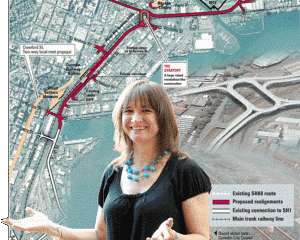Hundreds of intersections need modifications to make them safer ahead of the reversal of the left-turning traffic rule in five weeks.
Auckland Transport has surveyed 15,000 intersections throughout the region before the March 25 rule change, which is expected to prove a big challenge for many drivers already hazy about who has the right of way when turning.
Chief executive David Warburton says the modifications will mainly include new road markings, signs and timing adjustments to traffic signals. Work will start in the next fortnight.
Some intersections are likely to require longer lanes for drivers waiting to turn right, to minimise delays for straight-ahead traffic coming up behind them.
The Transport Agency will spend $1.2 million on publicity in the 10 days preceding the rule change, which will bring NZ into line with the world by requiring vehicles turning right at intersections to give way to those turning left.
It plans a "short and sharp'' campaign so drivers do not start practising too early for the change, causing extra mayhem on the roads.
Although right-turning vehicles have had the right of way since 1977, there is still considerable confusion among opposing drivers at intersections, and the agency has chosen what it hopes will be a quiet Sunday to revert to the previous regime.
Drivers turning right into uncontrolled intersections from "terminating'' roads will also be required to give way to those crossing their paths from the left, also reversing an existing rule.
The publicity drive will include a leaflet drop to 1.73 million households and video updates to the giveway.govt.nz website.
An engineering consultant who worked for the Ministry of Transport when the existing rule was introduced in 1977 told the Herald it was aimed at reducing delays for right-turning vehicles, which often had a long wait for gaps in opposing traffic.
He said left-turning vehicles had greater opportunities to turn, even when having to give way to traffic from the right, and he feared the rule change might increase frustration and risk-taking.
But Transport Agency spokesman Andy Knackstedt said there was a 2.5 per cent rise in intersection accidents after the 1977 rule was introduced, in contrast to a 7.1 per cent drop in Victoria, Australia, after a similar rule was reversed in 1993.
The agency expects the rule change to save, each year, an average of one life and prevent 97 injuries _ 13 of them serious.
Mr Knackstedt said
the move would improve safety for pedestrians and cyclists, as it would free left-turning drivers to concentrate on not running into them or cutting them off at intersections.
AA motoring affairs chief Mike Noon did not anticipate serious problems.
He said the implementation of the change was based on the way it was done in Victoria.
"That is, to have a really heavy burst of awareness in the two weeks or 10 days before the change comes into effect.
"Everyone was a bit more cautious and everyone was looking and paying attention. They also found that the number of crashes dropped.''
Mr Noon said the current give way rule was not well adhered to. "It's been in place for 30-odd years and people are still not obeying it. The current rule is quite complicated and the new rule is simple.
"It's not an enormous change, but in New Zealand we're not necessarily very good at showing courtesy. So, if someone is getting it wrong _ don't push ahead, let them through and just keep alert.''



